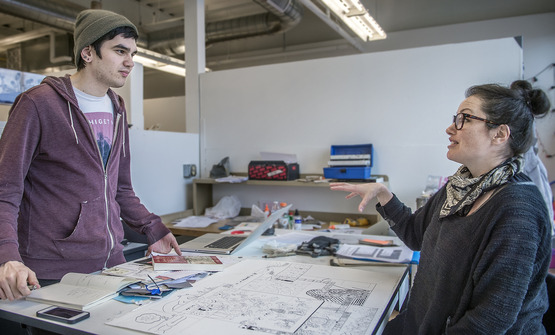
News . Feature Stories . Visiting artist liked CIA students' passion for experimentation
News
April 21, 2015
Visiting artist liked CIA students' passion for experimentation
Five questions for Cat Mazza

University of Massachusetts faculty member Cat Maza came to CIA in March as a visiting artist through the auspices of CIA’s George Bickford Fund for Visiting Artists. She gave a public presentation on her work, visited Sculpture + Expanded Media students in their studios, and critiqued their work. Afterward, she had these reflections to on her visit.
Your work draws from both digital art and craft disciplines. What did you think of the hybrid approaches to art making you saw in CIA’s Sculpture + Expanded Media Department?
I was really impressed with how CIA students were experimenting in various materials. Several students were using projections or had a time based element, constructing ambitious large scale sculpture and combining this with drawing, photo, fiber or painting.
Sculpture, as a discipline, is being redefined at CIA so that students are not restricted to working with one particular material, but can incorporate various materials, time-based technologies, and even sound art. Is this a trend you see nationally, and do you expect it to grow?
Opportunities for experimentation with many mediums is essential in art education. It would be limiting to force a single material or style of working. I think most practicing contemporary artists embrace more than one medium and it is appropriate for art schools to accommodate an interdisciplinary practice.
Knit for Defense, your short, black-and-white video made from footage of 20th century conflicts, is rendered with software that makes each pixel look like a hand-knitted stitch and it recalls war-time knitting drives. What did you think of CIA students’ awareness of socially engaged art and their ideas for making art that promotes peace or any other social priority?
Knit for Defense is in 3 parts and includes combat footage from WWII, the Vietnam War as well as aerial drone footage over Afghanistan from this century. CIA students were invested in how their concepts were being expressed and many were exploring social issues. Some of the most clever socially engaged art at CIA was a student making work in unsuspecting spaces: a baseball stadium, a sidewalk stand and a neglected lot nearby an elementary school. This work was trying to engage in discussions about who art is for and other issues like marginalized histories, poverty and race politics.
What’s your best piece of practical advice for aspiring artists?
Don't be afraid to expand your audience outside of your peer group, reach out to existing off-campus communities invested in your interests and exhibit early and often-- even if that means DIY pop-up exhibits and alternative spaces.
Did you get a chance to explore Cleveland while you were here and, if so, what did you think of our arts and cultural offerings?
I loved it. I made it to the Museum of Contemporary Art Cleveland, Cleveland Museum of Art, Dittrick Medical History Museum at Case Western and dined in the neighborhoods of Tremont and Gordon Square. I hope to come back soon.
Above, Cat Mazza visiting the studio of Sculpture + Expanded Media junior Bram Myers.
Latest Headlines view all
-
April 24, 2024
Cleveland Institute of Art welcomes alum Omari Souza as 2024 Commencement speaker -
April 02, 2024
Cleveland Institute of Art students partner with Progressive Art Collection to exhibit Ready, Set, Relay! -
March 04, 2024
Cleveland Institute of Art announces Curlee Raven Holton Inclusion Scholar Program
Questions?
For more information about this or other CIA news, contact us here.
Social Feed